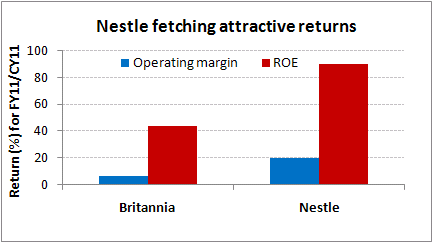- Home
- Outlook Arena
- Mar 27, 2012 - Britannia v/s Nestle: which is more delectable?
Britannia v/s Nestle: which is more delectable?
Branded & packaged foods, valued a little over Rs 1000 bn, is growing faster than the overall FMCG market. Britannia and Nestle are enduring brands in the Food & Beverages space and have registered robust growths of 18% and 20%, respectively during the last three years.
But where do they stand as far as their investment potential is concerned?
Revenue model
Britannia is the leading biscuit manufacturer. Its primary business is bakery consisting of biscuits, bread and cakes. The company operates in the dairy segment through its subsidiary Britannia Dairy. The dairy segment comprising of milk, butter, cheese, ghee and curds accounts for a mere 4.7% of the company's group turnover.
Nestle dominates the culinary and beverage segments. Milk products and nutrition is the largest segment with a 44% sales share. This is followed by prepared dishes & cooking aids and chocolate & confectionary segments with 28% and 14% share in overall revenues. Beverages make up for the balance 14% of sales.
Therefore Nestle has a more diversified product profile.
Cost dynamics
Despite being in the branded and packaged food business, both Britannia and Nestle have different cost dynamics.
Britannia is present in biscuits, the largest category having market size of Rs 124 bn in the branded & packaged foods. However, robust sales growth has not percolated to its bottomline. The reason is the price-sensitive nature of the industry as Marie & glucose biscuits, which are staples, comprise the largest share 60% of the overall biscuits market. The rest of the market is made up of differentiated biscuit products such as cream, cracker and milk biscuits. Thus low pricing power coupled with commodity inflation has nibbled away into the margins of biscuit companies since 2008-09. Britannia's operating margin slid from 10% in 2007-08 to around 6.5% in 2010-11.
Nestle, on the other hand, is present in premium categories such as milk powder, chocolate, coffee and soups. As these categories are relatively less price sensitive, the company enjoys better pricing power as compared to Britannia. Moreover, the company's distribution-to-sales ratio at 5% of is lower than Britannia's 7% ratio. Thus, Nestle has consistently maintained operating margin of approximately 20% since 2002.

|
|
|
Brand strength
Britannia is armed with well known biscuit brands such as Good Day, 50-50, Nutri-choice, Tiger, Treat and Milk Bikis. The company has been expanding the scope of its established brands into high margin product categories. The company extended Good-Day brand to the premium biscuits category, 50-50 brand to the snacks segment and Nutri-choice brand to the diabetic-friendly biscuit category. Apart from that, the company has launched gourmet cheese, value-added offerings in bread and healthy breakfast cereals.
Nestle is armed with a clutch of strong brands such as Everyday dairy whitener, Cerelac, Lactogen, Milkmaid, Nescafe, Maggi, Kit-Kit, Munch, Bar-One and Polo spanning product segments.
Nestle has been able to derive greater mileage from its brands as compared to Britannia.
Shareholder returns
It's no surprise that Nestle's highly profitable operations have enabled it to garner a superlative Return on Equity (ROE) of 90% in 2011, as compared to 44% ROE earned by Britannia in 2010-11. Both the companies have rewarded shareholders through consistent dividend payments with the pay-out ratio being more than 45%. In fact Britannia, in 2009-10, allotted shareholders with 8.25% secured, fully paid-up, redeemable non-convertible bonus debentures of the face value of Rs 170 for every equity share held. This has pushed the company's debt equity ratio to around two. Whereas, Nestle has a comfortable debt equity ratio of 0.76.
What does all this mean?
Both Britannia and Nestle have been registering robust sales growth. But Britannia's operating margin at 6.5% is a pittance as compared to Nestle's operating margin of 20%. Nestle's premium category-driven business model, which is relatively more inflation proof and highly profitable make it more attractive investment bet than Britannia.
However, going forward, Britannia is moving its brand portfolio to higher profit margin segments.
It is to be noted that the share of consumption of the low-margin glucose biscuits is on the decline. On the other hand, demand for non-staple biscuits, comprising of cream biscuits and cookies is growing rapidly.
Thus, Britannia with a large presence in the differentiated biscuit offerings is expected to benefit. Additionally, the company has been reducing dependence on the biscuits segment by expanding its dairy portfolio, and launching products in the wellness segment. These initiatives will benefit the company's margins favourably in the long run, and increase its "tastiness" as an investment.

Madhu Gupta (Research Analyst), ValuePro has a post graduate degree in both physics and finance. Having worked with India's leading economic research agency, she has a natural flair for numbers and analytics. She brings with her a near-decade long rich experience in the field of finance. A firm believer of the principles of value investing, she looks for robust businesses with durable competitive advantages.


Equitymaster requests your view! Post a comment on "Britannia v/s Nestle: which is more delectable?". Click here!
Comments are moderated by Equitymaster, in accordance with the Terms of Use, and may not appear
on this article until they have been reviewed and deemed appropriate for posting.
In the meantime, you may want to share this article with your friends!